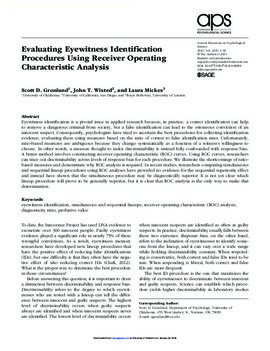Evaluating Eyewitness Identification Procedures Using Receiver Operating Characteristic Analysis

View/
Date
2014-02-01Author
Scott D. Gronlund
John T. Wixted
Laura Mickes
Metadata
Show full item recordSee DOI for License
Abstract
Eyewitness identification is a pivotal issue in applied research because, in practice, a correct identification can help to remove a dangerous criminal from society, but a false identification can lead to the erroneous conviction of an innocent suspect. Consequently, psychologists have tried to ascertain the best procedures for collecting identification evidence, evaluating them using measures based on the ratio of correct to false identification rates. Unfortunately, ratio-based measures are ambiguous because they change systematically as a function of a witness’s willingness to choose. In other words, a measure thought to index discriminability is instead fully confounded with response bias. A better method involves constructing receiver operating characteristic (ROC) curves. Using ROC curves, researchers can trace out discriminability across levels of response bias for each procedure. We illustrate the shortcomings of ratio-based measures and demonstrate why ROC analysis is required. In recent studies, researchers comparing simultaneous and sequential lineup procedures using ROC analyses have provided no evidence for the sequential superiority effect and instead have shown that the simultaneous procedure may be diagnostically superior. It is not yet clear which lineup procedure will prove to be generally superior, but it is clear that ROC analysis is the only way to make that determination.
Citation
Gronlund, S. D., Wixted, J. T., & Mickes, L. (2014). Evaluating Eyewitness Identification Procedures Using Receiver Operating Characteristic Analysis. Current Directions in Psychological Science, 23(1), 3-10. doi: 10.1177/0963721413498891